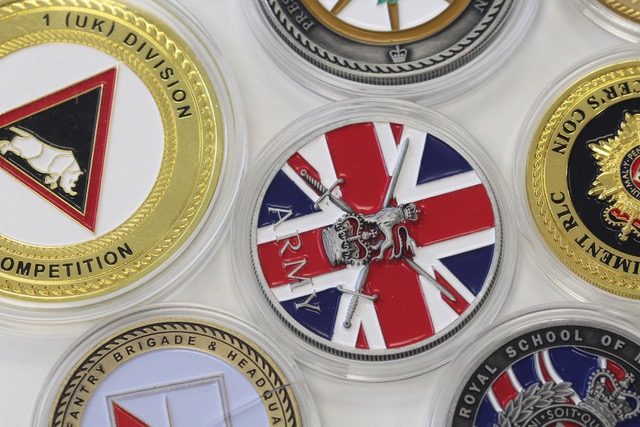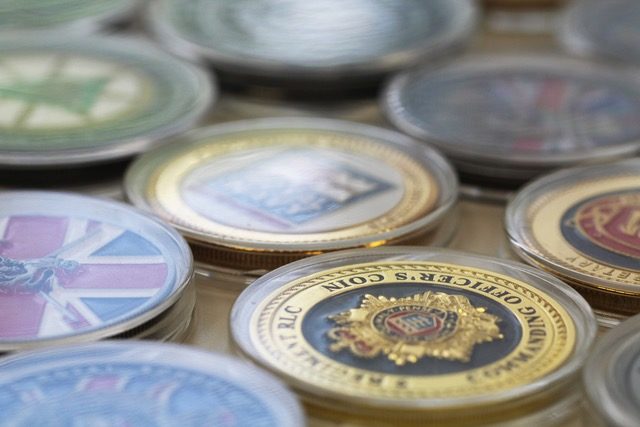This article is brought to you by sister brands, World Challenge Coins and The Koin Club. Founded by former Royal Marine Captain Ross Davies, Koin has been creating bespoke coins and commemoratives since 2012 and is proud to have worked with the military for so many years to create commemoratives. This July, The Koin Club sees the release of the Dunkirk 2017 Collection as well as continuations of their War Poppy Collection, Falklands Collection and History of the RAF Collection.
Collectible and creatively designed, the Challenge Coin in the modern era has always been associated with pride, fellowship, loyalty and camaraderie amongst a society of people whether that be the Forces, businesses or even gaming groups! Yet, what many people do not know, are the origins and past traditions of these exciting coins.
Let The Koin Club take you on a little, military history lesson and tell you about where this symbolic collectible actually comes from…
Early Challenge Coins
The ‘Challenge Coin’ has been around for a very long time, a thousand years! We can date the ‘first’ challenge coin back to the Roman Empire – where battle warfare was rife and not a lot of things had actually been made yet! However… coins had been… Enrolled soldiers would be honored for their bravery and courage during Roman battles if they performed well; not only would they receive their usual day’s pay but they’d also be given an extra coin for their hard work!
Some historians have noted that this reward coin would be minted with the legion of where it had come from and so that’s why, quite often, soldiers would keep their special coin as a keepsake of the battle… it would either be this or spend it on wine and women…
We can also see another early example of the Challenge Coin in the Renaissance period where ‘Portrait Medals’ were all the rage…especially in those ‘upper circles…’ With definite inspiration from Ancient Greek and Roman coinage, 15th-century Italy saw the rise of the medal along with the desire for personal fame and recognition. They were made of wood, stone or metal and would celebrate someone’s qualities, accomplishments, and special events. These medals symbolized typical Renaissance values such as harmony, dignity, and style. The reverse of the medal would have a portrait and the obverse would have an important image related to someone’s lineage, family, house or seal. These medals would be given as rewards or gifts and then passed amongst friends and associates… similar to the modern era medals today!

World War One
Probably the most recognized tale of the Challenge Coin is from World War One and it is a memorable one!
During WWI, a squadron of wealthy American officers and pilots, some say the Army Air Corps, were on their patrols across Europe. One officer in the squadron had decided before to have medallions struck so he could give them to his unit. One of the pilots (supposedly an Ivy League Lieutenant) placed his medallion under a leather pouch that hung around his neck.
On one of his next patrols, his plane was shot down behind enemy lines and he was captured by the Germans. As one of their PoWs, he was stripped of his identity and personal belongings…apart from the leather pouch that hung around his neck…
The brave prisoner eventually escaped the Germans by wearing civilian clothes and crossed into no-man’s land…only to be captured by the French! Thinking he was a German saboteur, the French decided that the best thing to do was to kill him.
So with no way of proving his identity and evading his execution, the miraculous pilot remembered he was wearing his leather pouch still… and what was in there? HIS MEDALLION aka HIS CHALLENGE COIN… So he showed his captors and remarkably, one of the Frenchmen recognized his squadron insignia! He was saved – rather than receiving a bullet, he received a bottle of wine from his captors!
On his return to his squadron, it became a marked tradition that all the members would have to carry their challenge coin at all times or else…a bullet…no, they’d simply just have to buy everyone in the unit if they didn’t show their coin when someone ‘challenged’ them to show it!
It is a great origin story; although there are other versions of the tale in the timeline. So just like the American pilot in Europe, there is another origin tale from World War Two which is quite similar to the WWI story; an American soldier marked a Philippine coin with his own unit crest in order to prove his own identity to a group of guerrillas fighting against Japanese invaders.
Post-World War Two
There are lots of similar origin tales but after WWII played host to an exciting continuation of ‘challenging.’ US Military personnel in post-WWII were assigned occupy Germany and with the exchange rate at the time, the German One Pfennig coin was worth very little – in fact, it was the smallest unit of German currency and was only worth a fraction of a US cent! They weren’t usually considered worth keeping unless you were short on money – but they did contribute to the game of ‘Pfennig Check!’ At any place where servicemen were getting together for a drink, if they were saving any West German Pfennigs, they’d have to show them! If a soldier brought out a Pfennig, it meant he had run out of money but if a soldier could not produce one, then it meant he had enough money to not have to save them…therefore, that unlucky soldier would have the next round on him!

Vietnam and Korean War
We can also see the tradition of the Challenge Coin during other wars. The Vietnam War saw soldiers on the front line carrying a special bullet (often lucky) behind enemy lines and on the elite front. At first they’d carry small arms ammunition but eventually, as the war went on, the lucky bullet would get larger and larger. This was dangerous so the commanders eventually banned them and decided to give metal coins to the soldiers engraved with the unit insignia. The main purpose of the bullet before was to have it ready when going to military bars or you’d have to buy everyone a drink.
The Korean War saw Colonel ‘Buffalo Bill’ Quinn of the 17th Infantry Regiment mint his own coins for his men. The coin had a buffalo on one side for Colonel Quinn and then the Regiment’s insignia on the other side of it. A hole was drilled in the top so men could wear them around their necks rather than in a leather pouch.
Secret Handshakes
Traditions of the Challenge Coin can also be recognized during the Second Boer War and the origins of challenge coins being passed in ‘secret handshakes’ can be seen. During this war, many mercenary soldiers were contracted and therefore, never rewarded (with medals, for example) for their valor due to their status. Some stories and depictions suggest that special officers would sneak into the tents of ‘undeserving’ recipients of medals and cut them from the ribbons they would have received. Later on, in a public ceremony, officers would call a deserving mercenary forward and secretly pass the medal in a palmed handshake – this would allow the soldier to be rewarded and indirectly help them for their service.
We can see secret handshakes being used to pass challenge coins in the modern era as well; in June 2011, Secretary of Defence Robert Gates on his retirement tour around Forces bases and hostile combat zones shook hands with numerous men and women in the military and to what many thought was a simple handshake – was actually a secret passing of a special, personal Secretary of Defence Challenge Coin.
This ritual of the ‘secret handshake’ has always been performed in the presence of others and although most ‘civilians’ do not see the passing of the challenge coin – it is a tradition that suggests to all those currently serving to carry one at all times, to build morale and uphold camaraderie.
Presidential Coins
With the modern use of passing challenge coins to soldiers, since Bill Clinton entering the White House, every president has had his own challenge coin and furthermore, since Dick Cheney, every vice president has had one as well. The White House coins are treated by collectors and numismatists as the most rare coins to acquire – the U.S. Secret Service has a coin for each special division that protects the President. Bill Clinton himself is a notable collector of challenge coins with his official portrait featuring his personal challenge coin collection in the background.
There are several, symbolic Presidential coins including the inauguration, the administration and one that can be bought by members of the public; however, there is only one, official coin that only the President himself can bestow upon someone at his own discretion. For example, George W Bush reserved his challenge coins for wounded servicemen who had fought in the Middle East. Barack Obama passed his out fairly often and wasn’t the best at keeping it a ‘secret handshake’ – in 2012, he tried to hand a coin to Sergeant Kristie Ness as he was boarding a Marine One helicopter and it was dropped rather awkwardly. He also quite often left challenge coins on the graves of fallen U.S. soldiers.
The tradition of the President passing over challenge coins has become a long-standing ritual so we shall have to see now what President Trump gives his challenge coins for…
Beyond the Forces
Although a significant part of the military tradition, challenge coins have been adopted by lots of other organizations and clubs. They are often used in business and other private organizations such as the Police and Fire Departments to inspire that military style of loyalty and camaraderie as well as honoring a valued member of the team. Challenge coins have all been made for the Scouts, World Series of Poker, NASCAR, the NFL and many more organizations.
Since our own formation in 2012, Koin Limited have made custom challenge coins for numerous organizations, corporations and businesses including the British Armed Forces, One Direction, Burger and Lobster Restaurants, Public Services, World of Tanks and even just for personal celebration.
Currently, we are running a limited time FREE Offer to own the ‘Raid of Remembrance’ Silver-Plated Commemorative… Order the Raid of Remembrance Collectable here…
To view our current commemoratives including our new Dunkirk release, click here…
From their earliest days in the Roman Empire to their circulation amongst soldiers in Vietnam, challenge coins have been a long-standing tradition of military history that has continued into the modern era. Nowadays, we can see challenge coins in not only Special Forces life but in other organizations as well all of which symbolizing a feeling of camaraderie, pride, and fellowship within a group.
